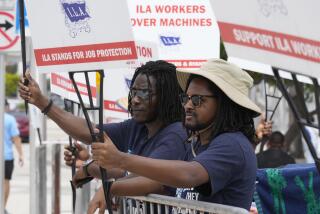July Is Goal for Ports’ New Hours
The ports of Los Angeles and Long Beach hope to finally shift to extended operating hours in July -- months after they originally had hoped to launch the plan aimed at avoiding 2004’s record backlogs and congestion.
“The most fundamental issue is that we cannot continue to work the way we work today. We can’t continue to operate the [terminal] gates from 8 a.m. to 5 p.m. on weekdays,” Bruce Wargo, president and chief executive of the so-called Pier Pass program, said Thursday. The program is intended to encourage shippers to move their cargo during off-peak hours.
Many ports, particularly in Asia, operate on a 24-hour basis. Los Angeles and Long Beach had been able to manage their traffic despite limited gate operating hours. That ended in 2004, when a labor shortage and record cargo levels kept more than 90 ships idled at dock and offshore for days on end.
Officials had hoped to begin the program late last year. Now, with a beefed-up force of marine clerks and longshore workers, officials were optimistic about meeting a late July start date.
To encourage shippers to switch to off-peak hours -- from 6 p.m. to 3 a.m. on weekdays and from 8 a.m. to 5 p.m. on Saturdays -- shipping containers moved through the port complex during peak hours will be assessed fees starting at $20 per 20-foot container and increasing to $40 per container after one month.
The ambitious goal, Wargo said, is to shift 15% to 20% of the container traffic to off-peak hours in the first year, 30% to 35% in the second year and 40% to 45% in the third year.
But some people are openly skeptical of the program’s chances of success.
“Pier Pass is going to be a failure,” said Stephanie Williams, spokeswoman for the California Truckers Assn. Truckers will have little or no incentive to work nights without extra pay, she said, adding that federal rules strictly limit the number of hours they can drive.
The International Longshore and Warehouse Union is also wary, vowing to hold the program to the same labor-contract standards it has with the West Coast shipping lines.
Others aren’t waiting to see whether Pier Pass is the answer. Some customers are already diverting cargo to other West Coast ports to avoid feared congestion. The Marine Exchange of Southern California, which tracks vessel movements, said there currently was no backlog at the ports, although some shippers are clearly concerned about the upcoming shipping season.
Traffic already is up substantially at the twin ports this year, with most of the growth coming at Long Beach. Projections for another record year -- 15.5 million 20-foot containers -- make the need for Pier Pass all the more pressing, Wargo said.
More to Read
Sign up for Essential California
The most important California stories and recommendations in your inbox every morning.
You may occasionally receive promotional content from the Los Angeles Times.











